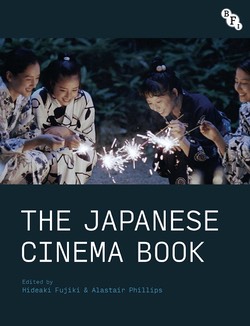I am trying to catch up on my blog announcements after encountering a server problem that prevented me from updating the site for several months. So here is post about a book I contributed to that appeared last year.

I am not sure if it is a trend in the academic publishing industry, but there is a spate of handbooks and introductory anthologies that has been appearing, even in the relatively small field of Japanese film studies. Oxford was first in 2014 with the Oxford Handbook of Japanese Cinema, edited by Daisuke Miyao (I have a piece in there on the history of Japanese film criticism). Last year the Routledge Handbook of Japanese Cinema came out, edited by Joanne Bernardi and Shota Ogawa (Routledge approached me about editing such a collection, but I didn’t take them up on the offer). Blackwell has another such collection in the works, edited by David Desser, which hopefully should come out soon (I have a contribution about the early relationship between TV and cinema in Japan).
Another such collection is The Japanese Cinema Book, which was published through the BFI and edited by Hideaki Fujiki and Alasteir Phillips. Pam Cook’s The Cinema Book, published by the BFI in 1985, was the key reference book for us studying for exams during grad school, so it was a pleasure to be able to participate in this project. I contributed a piece (which you can access here) on Morita Yoshimitsu’s Family Game for Alastair and Julian Philips’s Japanese Cinema: Texts and Contexts; and published the Japanese version of my article on Japanese film criticism in Kankyaku e no apurochi, which Fujiki edited.
As with these other handbooks and guidebooks, The Japanese Cinema Book attempts to offer a broad introduction to Japanese cinema and its study through basic concepts divided into seven parts: Theories and Approaches, Institutions and Industry, Film Style, Genre, Time and Spaces of Representation, Social Contexts, and Flows and Interactions. There are forty articles on such topics ranging from spectatorship and exhibition to set design and ecology, and authors including many of the top scholars in the world (including two of my former students: Naoki Yamamoto and Ryan Cook). You can see the table of contents on the Bloomsbury site (here). It is all very impressive and took years to complete.
My contribution is “Early Cinema: Difference, Definition, and Japanese Film Studies,” in which I not only review some of the major contributions in the study of the first decades of Japanese film history, but also comment on how central research on early cinema was to the development of Japanese film studies, a centrality that has been lost. This is due in part to problems in recent early cinema research, but it also reflects on the field as a whole. This was not an easy article to write, in part because I had to write about myself (and my third book, Visions of Japanese Modernity), but also because I had to write critically about close colleagues. I hope the piece is productive in the end.
Here’s the bibliographic info:
- Aaron Gerow, “Early Cinema: Difference, Definition, and Japanese Film Studies,” The Japanese Cinema Book, eds. Hideaki Fujiki and Alastair Phillips (London: British Film Institute, 2020), pp. 25-37. ISBN 9781844576784. Get it at Powells.

